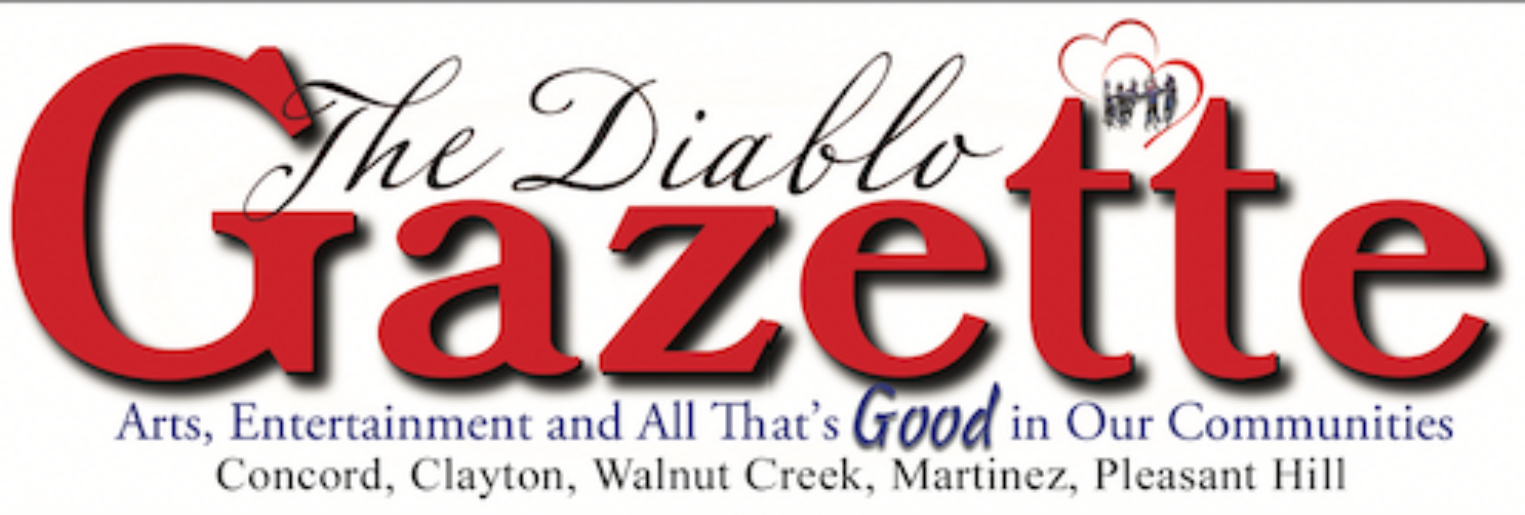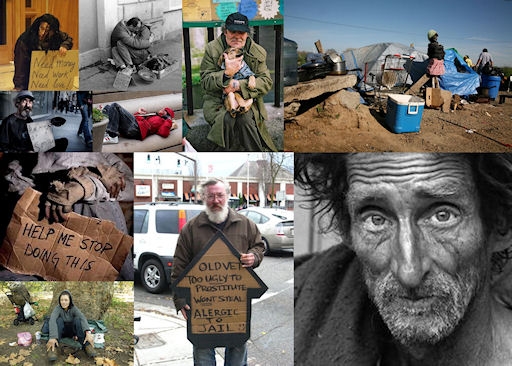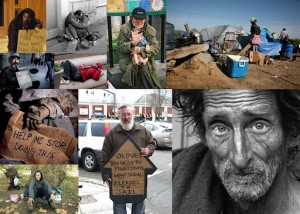By Richard Eber
It was a shock for many people including myself to learn Doug Stewart of the Homeless Outreach Program announced he is quitting his work with the organization and moving to Arizona this July.
Even though we are pleased that Doug will be able to spend quality time with his aging parents and siblings, his departure feels much like a death in the family because he will be so sorely missed. Each evening, for more than a decade Stewart, worked with the homeless throughout Contra Costa making the rounds to their encampments throughout the region.
For this, Doug has never been paid or given the plaques and certificates city councils are so fond of dispensing to charity organizations. Doug Stewart has given his life to the homeless out of the goodness of his heart.
Driving around in a beaten-up, white van, Stewart has rendezvoused with the most desperate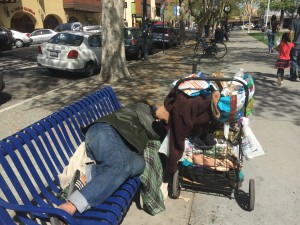 and problem plagued segment of our society. While bringing them food, socks, blankets, jackets, medical supplies and other essentials, he also brought hope. The homeless of Contra Costa have known they have had a trusted friend they could depend on.
and problem plagued segment of our society. While bringing them food, socks, blankets, jackets, medical supplies and other essentials, he also brought hope. The homeless of Contra Costa have known they have had a trusted friend they could depend on.
Outside of visiting the shanty towns mostly located under freeway underpasses or near abandoned railroad tracks, the Homeless Outreach Program has been the community’s primary resource to refer social services to those in need.
Doug Stewart and his associates insist that those who want to change their lifestyle must be ready to make a commitment to leave the streets. It’s tough love. In most cases, this has meant alcoholics must go on the wagon prior to seeking treatment at a detox facility. A similar scenario has held true for drug addicts, a large segment of the homeless population.
Along with those who have chemical dependency issues, others living in the streets are plagued with mental disabilities that preclude them from living normal lives. Many are individuals who have been cast aside when cutbacks in Governmental agencies of mental health services have occurred over the years. Tragically, it often costs society more to serve these people when they are homeless, especially when law enforcement and medical issues are factored in.
Doug’s compassionate undertaking is a daunting dose of good will. To put things in perspective, let me recount one evening I spent with Doug and the Homeless Outreach Program last year.
6:35 p.m. We start out this night in a parking lot near the train depot in Martinez. The first order of business is to stock the Ford 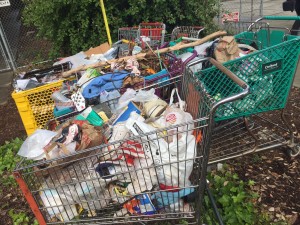 Van with supplies at a nearby donated warehouse. Blankets, socks, and canned foods are the main items loaded up. The materials distributed depend on need and what is donated by businesses and charities to the Homeless Outreach program on a daily basis.
Van with supplies at a nearby donated warehouse. Blankets, socks, and canned foods are the main items loaded up. The materials distributed depend on need and what is donated by businesses and charities to the Homeless Outreach program on a daily basis.
7:50 p.m. Our first mission is to pick-up Freddy C. in Antioch. He is to be taken to a homeless shelter in Richmond where Doug has found space for him. We arrive at this encampment next to the railroad tracks adjacent to a long deserted card room whose faded signs evoke better times. The parking lot consists of a long line of shopping carts in front of make-shift huts.
In trying to locate Freddy, Doug in the tradition of a modern Johnny Appleseed dispenses socks in the dwellings where approximately 35 down-and-outers reside. Most of the people there know Doug and are glad to see him. Developing trust is important should anyone desire to turn their lives around.
8:15 p.m. The word has gotten around and Freddy appears just before we were preparing to leave. After he is checked for dangerous weapons, we are in transit to the shelter in Richmond where a vacancy exists. There are a limited amount of beds available so priority is given by Doug for those who are likely to be successful in getting off the streets.
With little prodding, Freddy tells his story of having lived with his Grandmother after his marriage fell apart caused by bouts of binge drinking. He was hoping to reconcile with his wife when a drunken episode occurred that resulted in Freddy beating up his Grandma’s boyfriend. This resulted in more trouble with the law and a ticket to homeless world. After recounting this tale Freddy told us he was not a bad guy when not on the bottle. I wanted to believe him but said nothing.
8:50 p.m. We arrive at the County Shelter in Richmond. While Doug is checking Freddy in, I hung out in the nearby Courtyard where clients of the facility are smoking cigarettes prior to check-in time. They are joined by residents of the homeless encampment that I would later learn is located nearby.
One individual that stands out is a well dressed young Hispanic kid in his early 20’s who does not appear to belong in this environment. A few minutes later when Doug returns, he begins a conversation in Spanish with Rico who is new to the area. He claims to have recently arrived from Mexico and become destitute when separated from his family.
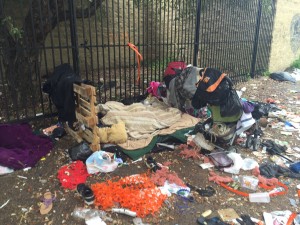 9:33 p.m. After finishing up at the Homeless Shelter we begin touring the nearby encampments located near the railroad tracks. Even though there are dirt roads leading to these places, Doug’s van is not sturdy enough to traverse through this terrain. It requires a 4-wheel drive vehicle. Parking next to a fenced off storage area armed with blankets, socks, and a few medical supplies, we walk around with only a flashlight to guide us. We visit abandoned sites and places where the residents are not around. Doug leaves his card to show having been there.
9:33 p.m. After finishing up at the Homeless Shelter we begin touring the nearby encampments located near the railroad tracks. Even though there are dirt roads leading to these places, Doug’s van is not sturdy enough to traverse through this terrain. It requires a 4-wheel drive vehicle. Parking next to a fenced off storage area armed with blankets, socks, and a few medical supplies, we walk around with only a flashlight to guide us. We visit abandoned sites and places where the residents are not around. Doug leaves his card to show having been there.
10:23 p.m. We come to shantytown where about 15 people are living. There are tents and signs of cooking fires in use. The residents are happy to see Doug and gratefully accept any goodies he offers. Seeing the mess on the ground of assorted garbage, he implores those present to clean up their camp. As a reward for doing this, Doug offers them a bucket of Colonel Sanders fried chicken next week should they comply with his wishes.
Litter, including empty beer cans and used syringes can be easily found. With no lavatory facilities, empty stream beds are filled with human feces that will one day pollute the Bay when the rains come. He said that when the County comes in to clean up the camps, they must send in a Hazmat team which is very expensive. By comparison a bucket of chicken seems like a bargain, Doug reasoned.
11:01 p.m. We ask around and are directed to the camp where the mystery man Rico allegedly lives. When we find this place, there is a tent and suitcase but no food, sleeping bag or fire pit present. Doug suspects that Rico is the local drug dealer sent in by a gang to sell to the addicts residing in the Homeless Shelter and close by encampments.
Apparently, it is not a coincidence that Rico wears a fashionable leather coat, gold chains, and clean clothes. He definitely does not fit the profile of a resident of these places. Stewart, who has a close working relationship with the local police forces in the County, will likely pass on this bit of intelligence at the appropriate time
11:27 p.m. Hurrying to the van, our tour heads to Nation’s Giant Burger parking lot near to Casino San Pablo. We are supposed to meet a lady who is voluntarily committing herself to a drug treatment program. Our appointment is at 11:45. When Cheryl does not show, we head off to the Martinez jail to pick up a recently released convict who has been promised a ride to a Homeless camp in Concord a couple hundred yards from the Sam’s club parking under the bridge where Walnut Creek intermittently flows.
12:15 a.m. Waiting for us in what is turning out to be a chilly evening, we meet Paul and Luanne who are a couple in their late 20’s. Paul was just let out of the County Jail after being held for possession of heroin. I am told that despite the seriousness of the crime, law enforcement does not hold criminals of this kind very long because it does little good nor solves any problems.
As a precaution, Doug searched the couple prior to letting them in the van. He confiscated a switchblade knife and a small bag of marijuana which was later returned to them. While driving to their drop off point in Concord, we learn that Paul grew up in the area and comes from a broken home with a drunken Mom and a drug-addicted father.
He expressed desire to turn his life around while professing love for Luanne who at second glance was several years older than him. With drug addicts, it is sometimes difficult to know their ages because needle and the hard life on the streets quickly take its toll.
12:40 a.m. Before reaching the appointed destination near Sam’s Club, Luanne asks if they can be dropped off at a 7-11 in Pacheco to get a hot meal despite claiming to be penniless. Ignoring the holes in their story, Doug complies and drives them to the convenience store.
After they disembark and his card is given to each of them, Doug explains that the couple was looking for a dealer to get a fix. He says the only hope for either one of them is to split up and seek treatment. Should that moment ever come, both have his contact information.
1:10 a.m. Somewhat exhausted, I am dropped off at my car in Martinez. For Doug Stewart, his work for that day is just beginning. He is scheduled to make his rounds beneath a freeway underpass in Pleasant Hill and go on from there in his mission to bring comfort for those most in need.
For me life will never be the same. Every time I pass by a freeway on ramp, I will wonder what is going on underneath in the dark world of the homeless nation.
At the end of day how does our society replace Doug Stewart as he rides off into the Sunset in Arizona? The measly $ 165,000 or so given to Homeless Outreach by public agencies is a drop in the bucket considering all the work the program accomplishes. Despite performing services that would make Mother Teresa proud, procuring the necessary resources to carry out their mission has never been easy.
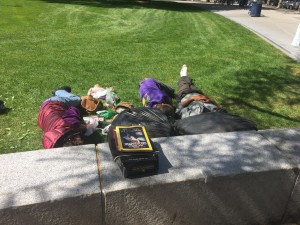 Getting even a small amount of support from the county government has proved to be as difficult to obtain as winning the lottery. The problem is that almost all Federal and State money they distribute to assist the homeless must be in the form of services that are intended to take people off the streets permanently rather than address immediate needs.
Getting even a small amount of support from the county government has proved to be as difficult to obtain as winning the lottery. The problem is that almost all Federal and State money they distribute to assist the homeless must be in the form of services that are intended to take people off the streets permanently rather than address immediate needs.
Most funds are allocated to programs primarily administered by churches, community groups, and various entities that can write grant proposals. When it’s time to dish out the cash, Homeless Outreach historically has been left out in the cold with their clients.
To government, on virtually all levels, what Doug Stewart has done in helping these poor souls takes a backseat to what are considered to be higher priorities.
Now, Doug is moving on to fulfilling a dream he never thought possible. He’s purchasing a home in Payson, Arizona and starting a new life. Unless someone steps forward, Stewart will be taking his foundation with him.
What is to happen following Doug’s departure? No amount of Ph D’s, sociologists, program administers, or social workers can fill the void he will have left behind.
Government and private organizations will need to take drastic steps to replace what Doug Stewart, associate Bill Schilz, and others with Homeless Outreach have accomplished. Hopefully, the powers that be will be able to find some way to duplicate at least part of the work that they have done.
Dealing with these outcasts of society has been the mission of Doug Stewart. No amount of funding can ever replace his compassion. During the past year, Doug and his team successfully sheltered 1040 homeless individuals, and provided some 3000 people with the necessities to survive, and even helped relocate some 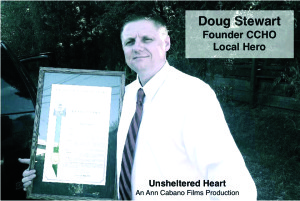 homeless folks to relatives far away. Offering referrals to those with no place to turn, desperate and destitute, was equally important.
homeless folks to relatives far away. Offering referrals to those with no place to turn, desperate and destitute, was equally important.
Doug has been honored for his work with several awards. Martin Luther King Contra Costa County Humanitarian of the Year 2013; Martinez Man of the Year 2011; Diablo Magazine “Threads of Hope Award 2011; President’s Call to Service Award; American Red Cross Heroism Award 2012; Concord PD Community Policing Award 2012; California Peace Officers Award of Appreciation 2013. He was also featured in the documentary “Unsheltered Heart”, currently still in production.
Too much is at stake to let this program die. Homelessness is problematic to all communities. It’s what is wrong. It’s ugly and it blinds us. Doug Stewart had eyes. He has shown us an incredible side of humanity as an unpaid soldier of decency, motivated by his sheer desire to help a desperate man, with the fortitude to act… Doug is what is right within our area.
Diablo Gazette Extra – Our local officials had this response to this story.
Assemblywoman Susan Bonilla, District 14
“Doug has been an unsung hero in Contra Costa County directly serving the homeless community for over 10 years. His tireless efforts and financial commitment will undoubtedly be a challenge to match, but his decision to move closer to care for his parents in Arizona is just another testament to his true character. His absence will create a large gap in service delivery to our county’s homeless population.” – Assemblywoman Susan Bonilla
County Supervisor Karen Mitchoff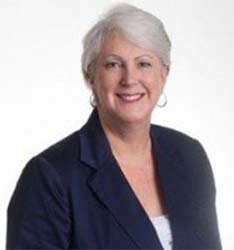
Contra Costa County understands that homelessness is a serious concern. Our County Homeless Services is currently designing a coordinated entry system that will provide the homeless with a more streamlined way to access housing and services. Contra Costa County wants to make sure that the homeless get the right resource at the right time.”
Here are some of things we are currently doing.
- The Coordinated Entry system provides a more streamlined way for people to access housing and services so that people get the right resource at the right time.
- Zero: 2016 campaign data: through February, 216 veterans and 229 chronically homeless people have been placed in permanent housing in Contra Costa County.
- Engaging and retaining landlords who will rent to special needs populations is essential for ending homelessness. The Zero:2016 campaign has been working hard to find ways to increase the number of units available in the community. – County Supervisor Karen Mitchoff
Senator Steven Glazer
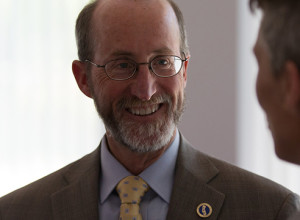 “There are 28,000 chronically homeless people in California – many of whom are mentally ill. Not only should we provide a helping hand to those who can’t help themselves, but we must get a handle on the costs. The cost of homelessness is $100,000 annually per person with emergency room visits, hospital stays, law enforcement, and other social services.
“There are 28,000 chronically homeless people in California – many of whom are mentally ill. Not only should we provide a helping hand to those who can’t help themselves, but we must get a handle on the costs. The cost of homelessness is $100,000 annually per person with emergency room visits, hospital stays, law enforcement, and other social services.
“I am a co-author of legislation that would build or rehabilitate 10,000 to 14,000 permanent housing units for chronically homeless persons with mental illnesses. This would be paid for by $2 billion in bonds paid for by the state over 20 to 30 years with Proposition 63 money, the “millionaires’ tax” for mental health services.
“The legislation would also provide $200 million, over 4 years from the state’s general fund, to pay for short-term rent subsidies while permanent housing is constructed or rehabilitated.” – Sen. Glazer
Assemblywoman Catharine Baker District 16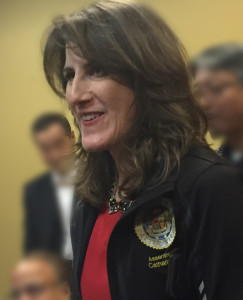
“Just last week I visited the Trinity Crisis Center in Walnut Creek and spoke with several homeless members in our community. We discussed what some of the overall causes of homelessness are, and what needs to be done to help address it. It was very clear that homelessness doesn’t have one simple solution or magic bullet, and it is not something that can be solved just by throwing money at it. It takes partnerships, public and private efforts, good government policies to ensure housing is affordable and isn’t out of reach, and jobs and job skills training is more readily available and accessible to the homeless community.” — Assemblywoman Catharine B. Baker
